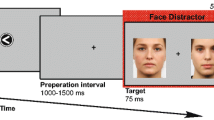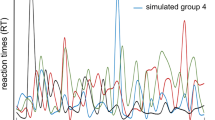Abstract
Fortysix Attention Deficit Disorder (ADD) adolescents took a Continuous Performance Test (CPT) under placebo and methylphenidate (35.33 mg/day). The task required pressing one button for targets (p=133),and another button for nontargets. Subjects displayed a strong bias to make the more frequent negative response before completely evaluating stimuli. Consistent with this assumption, subjects responded faster (by an average of 87 ms) to nontargets than to targets. Methylphenidate increased accuracy and speeded reaction times (RTs) to targets. The drug also increased the amplitude of the P3b component of the eventrelated potential for nontargets and shortened the latency of P3b for both targets and nontargets. These results suggest increased capacity allocation to and faster evaluation of task stimuli. Finally, the stimulant lengthened relative motor processing time (RT-P3b latency) for nontargets, a finding implying that response processing was accomplished with the benefit of earlier completion of evaluation processes for these stimuli.
Similar content being viewed by others
References
Aman, M. G. (1978). Drugs, learning, and the psychotherapies. In J. S. Werry (Ed.),Pediatric Psychopharmacology (pp. 79–108). New York: Brunner/Mazel.
Callaway, E. (1983). The pharmacology of human information processing.Psychophysiology, 20, 359–370.
Callaway, E. (1984). Human information-processing: Some effects of methylphenidate, age, and scopolamine.Biological Psychiatry, 19, 649–662.
Cohen, N. J., Weiss, G., & Minde, K. (1972). Cognitive styles in adolescents previously diagnosed as hyperactive.Journal of Child Psychology and Psychiatry, 13, 203–209.
Conners, C. K., & Werry, J. S. (1979). Pharmacotherapy. In H. C. Quay & J. S. Werry (Eds.),Psychopathological disorders of childhood (2nd ed., pp. 336–386). New York: Wiley.
Cook, E. W., III (1981). FWTGEN — An interactive FORTRAN II/IV program for calculating weights for a non-recursive digital filter.Psychophysiology, 18, 489–490.
Coons, H. W., Klorman, R., & Borgstedt, A. D. (1987). Effects of methylphenidate on adolescents with a childhood history of Attention Deficit Disorder: II. Information processing.Journal of the American Academy of Child and Adolescent Psychiatry, 26, 368–374.
Douglas, V. I. (1983). Attentional and cognitive problems. In M. Rutter (Ed.),Developmental neuropsychiatry (pp. 280–329). New York: Guilford Press.
Fitzpatrick, P., Klorman, R., Brumaghim, J. T., & Keefover, R. W. (1988). Effects of methylphenidate on stimulus evaluation and response processes: Evidence from performance and event-related potentials.Psychophysiology, 25, 292–304.
Ford, J. M., Pfefferbaum, A., Tinklenberg, J., & Kopell, B. A. (1982). Effects of perceptual and cognitive difficulty on P3 and RT in young and old adults.Electroencephalography and Clinical Neurophysiology, 54, 311–321.
Garfinkel, B. D., Brown, W. A., Klee, S. H., Braden, W., Beauchesne, H., & Shapiro, B. A. (1986). Neuroendocrine and cognitive responses to amphetamine in adolescents with a history of Attention Deficit Disorder.Journal of the American Academy of Child Psychiatry, 25, 503–508.
Gittelman, R., & Kanner, A. (1986). Psychopharmacotherapy. In H. C. Quay & J. S. Werry (Eds.),Psychopathological Disorders of Childhood (3rd ed., pp. 455–494). New York: Wiley.
Gittelman, R., Manuzza, S., Shenker, R., & Bonagura, N. (1985). Hyperactive boys almost grown up. I. Psychiatric status.Archives of General Psychialry, 42, 937–947.
Goyette, C. H., Conners, C. K., & Ulrich, R. F. (1978). Normative data on revised Conners parent teacher rating scales.Journal of Abnormal Child Psychology, 6, 221–236.
Gratton, G., Coles, M. G. H., & Donchin, E. (1983). A new method for off-line removal of ocular artifact.Electmencephalography and Clinical Neurophysiology, 33, 468–484.
Hechtman, L., Weiss, G., & Perlman, T. (1984). Young adult outcome of hyperactive children who received long-term stimulant treatment.Journal of the American Academy of Child and Adolescent Psychiatiy, 23, 261–269.
Herjanic, B., & Reich, W. (1982). Development of a structured psychiatric interview for children: Agreement between child and parent on individual symptoms.Journal of Abnormal Child Psychology, 10, 307–324.
Hochaus, L. (1972). A table for the calculation ofd' and beta.Psychological Bulletin, 77, 375–376.
Hoy, E., Weiss, G., Minde, K., & Cohen, N. (1978). The hyperactive child at adolescence: Cognitive, emotional and social functioning.Journal of Abnormal Child Psychology, 6, 311–324.
Isreal, J. B., Chesney, G. L., Wickens, C. D., & Donchin, E. (1980). P300 and tracking difficulty: Evidence for multiple resources in dual-task performance.Psychophysiology, 17, 259–273.
Klorman, R. (1986). Attention deficit disorder in adolescence. In R. A. Feldman & A. R. Stiffman (Eds.),Advances in adolescent mental health (Vol. 1, Pt. A, pp. 19–62). Greenwich, CT: JAI Press.
Klorman, R., Brumaghim, J. T., Fitzpatrick, P. A., & Borgstedt, A. D. (1990). Clinical effects of a controlled trial of methylphenidate on adolescents with Attention Deficit Disorder.Journal of the American Academy of Child and Adolescent Psychiatry, 29, 702–709.
Klorman, R., Brumaghim, J. T., Fitzpatrick, P. A., & Borgstedt, A. D. (in press). Methylphenidate ameliorates cognitive abnormalities of Attention Deficit Disordered adolescents.Journal of Abnormal Psychology.
Klorman, R., Coons, H. W., & Borgstedt, A. D. (1987). Effects of methylphenidate on adolescents with a childhood history of Attention Deficit Disorder: I. Clinical findings.Journal of the American Academy of Child and Adolescent Psychiatry, 26, 363–367.
Loiselle, D. L., Stamm, J. S., Maitinsky, S., & Whipple, S. C. (1980). Evoked potential and behavioral signs of attentive dysfunction in hyperactive boys.Psychophysiology, 17, 193–201.
Magliero, A., Bashore, T. R., Coles, M. G. H., & Donchin, E. (1984). On the dependence of P300 latency on stimulus evaluation processes.Psychophysiology, 21, 171–186.
Myers, J. L. (1972).Fundamentals of experimental design (2nd ed.). Boston: Allyn and Bacon.
Peloquin, L. J., & Klorman, R. (1986). Effects of methylphenidate on normal children's mood, event-related potentials, and performance in memory scanning and vigilance.Journal of Abnormal Psychology, 95, 88–98.
Pfefferbaum, A., Christensen, C., Ford, J. M., & Koppel, B. S. (1986). Apparent response incompatibility effects on P3 latency depend on the task.Electroencephalography and Clinical Neurophysiology, 21, 159–170.
Rosenthal, R. H., & Allen, T. W. (1978). An examination of attention, arousal, and learning dysfunctions of hyperkinetic children.Psychological Bulletin, 85, 689–715.
Sanders, A. F. (1990). Issues and trends in the debate on discrete vs. continuous processing of information.Acta Psychologica, 74, 123–167.
Seidel, W. T., & Joschko, M. (1990). Evidence of difficulties in sustained attention in children with ADDH.Journal of Abnormal Child Psychology, 18, 217–229.
Sergeant, J. (1988a). Functional deficits in attention deficit disorder. In L. M. Bloomingdale (Ed.),Attention deficit disorder (Vol. 3, pp. 1–19). Oxford: Pergamon Press.
Sergeant, J. (1988b). From DSM-III attentional deficit disorder to functional deficits. In L. M. Bloomingdale & J. A. Sergeant (Eds.),Attention deficit disorder (Vol. 5, pp. 183–198). Oxford: Pergamon Press.
Sroufe, L. A. (1975). Drug treatment of children with behavior problems. In F. Horowitz (Ed.),Review of child development research (Vol. 4, pp. 347–407). Chicago: University of Chicago Press.
Sternberg, S. (1969). Memory scanning: Mental processes revealed by reaction-time experiments.American Scientist, 57, 421–457.
Tannock, R., Schachar, R. J., Carr, R. P., Chajczyk, D., & Logan, G. D. (1989). Effects of methylphenidate on inhibitory control in hyperactive children.Journal of Abnormal Child Psychology, 17, 473–491.
van der Meere, J., van Baal, M., & Sergeant, J. (1989). The additive factor method: A differential diagnostic tool in hyperactivity and learning disability.Journal of Abnormal Child and Adolescent Psychology, 17, 409–422.
Varley, C. K. (1983). Effects of methylphenidate in adolescents with attention deficit disorder.Journal of the American Academy of Child Psychiatry, 22, 352–354.
Werry, J. S., & Sprague, R. L. (1970). Hyperactivily. In C. G. Costello (Ed.),Symptoms of psychopathology (pp. 387–417). New York: Wiley.
Yellott, J. I. (1971). Correcting for fast guessing and the speed-accuracy trade-off in choice reaction time.Journal of Mathematical Psychology, 8, 159–199.
Zambelli, A. J., Stamm, J. S., Maitinsky, S., & Loiselle, D. L. (1977). Auditory evoked potentials and selective attention in formerly hyperactive adolescent boys.American Journal of Psychiatry, 134, 742–747.
Author information
Authors and Affiliations
Additional information
Portions of these findings were reported at the meeting of the Society for Research in Child and Adolescent Psychopathology, Costa Mesa, California, January 24–26, 1990. This research was supported by NIMH grant MH38118 to the first author. We thank the late Helen Pollock and the University of Rochester's Strong Memorial Hospital Pharmacy Manufacturing Department for their help.
Rights and permissions
About this article
Cite this article
Klorman, R., Brumaghim, J.T., Fitzpatrick, P.A. et al. Methylphenidate speeds evaluation processes of Attention Deficit Disorder adolescents during a continuous performance test. J Abnorm Child Psychol 19, 263–283 (1991). https://doi.org/10.1007/BF00911231
Revised:
Issue Date:
DOI: https://doi.org/10.1007/BF00911231




